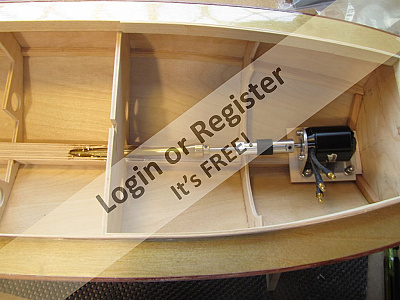Join Us On Social Media!
DIFFERENCES BETWEEN OUTRUNNER AND INRUNNER BRUSHLESS MOTORS
6 Posts · 2 Followers · 8 Photos · 20 Likes
Began 2 months ago by
Follow This Thread
Not currently following
> Click to follow
> Click to follow
Latest Post 2 months ago by
( Newest Posts Shown First )
📝 DIFFERENCES BETWEEN OUTRUNNER AND INRUNNER BRUSHLESS MOTORS
26 Views · 1 Like
Country: 🇬🇧 United Kingdom
Online: 6 hours ago
Online: 6 hours ago
Thanks Alessandro. Conversely, thank you for your information on brushed motors which I know little about. I do have some in my RTR boats but obviously they came installed with them.
I did think about using them in my slower models; River Cruiser, Fisherman and Faun but decided to stick with my favoured brushless, particularly having tried one in the River Cruiser where slow speed and moving off were very good. Some might think I'm crazy using brushless in such slow models. I could have got advice on what brushed to use but part of my decision was wanting to see how brushless worked in slow craft as I'd read mixed reports on their slow speed performance - the answer is to use decent quality motors and ESCs. Fisherman will be the interesting one as it will be pretty heavy, has a blunt nosed displacement hull with a very small motor.
The total opposite to my planing models where I oversize the motors!
I did think about using them in my slower models; River Cruiser, Fisherman and Faun but decided to stick with my favoured brushless, particularly having tried one in the River Cruiser where slow speed and moving off were very good. Some might think I'm crazy using brushless in such slow models. I could have got advice on what brushed to use but part of my decision was wanting to see how brushless worked in slow craft as I'd read mixed reports on their slow speed performance - the answer is to use decent quality motors and ESCs. Fisherman will be the interesting one as it will be pretty heavy, has a blunt nosed displacement hull with a very small motor.
The total opposite to my planing models where I oversize the motors!
▲
⟩⟩
AlessandroSPQR
Scratch building 7 Faireys at a scale of 1:12
📝 DIFFERENCES BETWEEN OUTRUNNER AND INRUNNER BRUSHLESS MOTORS
31 Views · 2 Likes
Country: 🇮🇹 Italy
Online: 16 hours ago
Online: 16 hours ago
Hi Chris, this information, based on your knowledge and personal experience, is very useful to me, but I think it will be useful to others as well. Thanks for sharing.
▲
⟩⟩
hermank
ChrisF
📝 DIFFERENCES BETWEEN OUTRUNNER AND INRUNNER BRUSHLESS MOTORS
31 Views · 1 Like
Country: 🇮🇹 Italy
Online: 16 hours ago
Online: 16 hours ago
Thanks Bob, that's very kind of you.
▲
⟩⟩
hermank
📝 DIFFERENCES BETWEEN OUTRUNNER AND INRUNNER BRUSHLESS MOTORS
71 Views · 6 Likes
Country: 🇬🇧 United Kingdom
Online: 6 hours ago
Online: 6 hours ago
Duncan, as Bob has demonstrated, inrunner motors can be used in "slower" models 😀 but usually they are used in models where higher revs are required e.g. fast electrics/raceboats and those with water jets.
Outrunners offer more than enough performance for sports cruisers where you don't really need more than 10k. rpm on the water (12k. out) and the prop shaft can be the limiting factor whereas raceboats usually use flexible drives.
I usually recommend outrunners for heavier sports cruisers and speed boats as for a given motor diameter they offer more torque but in reality brushless motors are so powerful it doesn't really matter!
The rpm of brushless motors (sorry if you know this) is governed by the kV stated which equates to 1000 rpm per battery volt which can lead to some seriously high rpm with inrunners as they can have very high kV.
I was late to the party as regards model boats and use brushless motors in all my builds, even the very slow ones, as I just love their engineering. Most of mine are outrunners with the one exception being my future water-jet jet project where high revs are beneficial and so I'm using an inrunner. Also inrunners can be more effectively cooled by using a water-jacket as the outer casing doesn't spin.
First photo shows an outrunner in one of my Fairey sports cruisers and the second is an inrunner as used in my water-jet project fitted with a cooling jacket.
Chris


Outrunners offer more than enough performance for sports cruisers where you don't really need more than 10k. rpm on the water (12k. out) and the prop shaft can be the limiting factor whereas raceboats usually use flexible drives.
I usually recommend outrunners for heavier sports cruisers and speed boats as for a given motor diameter they offer more torque but in reality brushless motors are so powerful it doesn't really matter!
The rpm of brushless motors (sorry if you know this) is governed by the kV stated which equates to 1000 rpm per battery volt which can lead to some seriously high rpm with inrunners as they can have very high kV.
I was late to the party as regards model boats and use brushless motors in all my builds, even the very slow ones, as I just love their engineering. Most of mine are outrunners with the one exception being my future water-jet jet project where high revs are beneficial and so I'm using an inrunner. Also inrunners can be more effectively cooled by using a water-jacket as the outer casing doesn't spin.
First photo shows an outrunner in one of my Fairey sports cruisers and the second is an inrunner as used in my water-jet project fitted with a cooling jacket.
Chris


▲
⟩⟩
hermank
BOATSHED
DuncanP
AlessandroSPQR
EdW
RNinMunich
Scratch building 7 Faireys at a scale of 1:12
📝 DIFFERENCES BETWEEN OUTRUNNER AND INRUNNER BRUSHLESS MOTORS
70 Views · 2 Likes
Country: 🇬🇧 United Kingdom
Online: 6 hours ago
Online: 6 hours ago
Nicely explained Alessandro - well done 👍
Bob.
Bob.
▲
⟩⟩
hermank
AlessandroSPQR
Never too old to learn
📝 DIFFERENCES BETWEEN OUTRUNNER AND INRUNNER BRUSHLESS MOTORS
72 Views · 8 Likes
Country: 🇮🇹 Italy
Online: 16 hours ago
Online: 16 hours ago
Hi Duncan, I'll answer your question.
Both inrunner and outrunner motors are brushless.
In brushless motors, the winding is on the fixed part, unlike brushed motors, which have the winding on the rotor (in fact, to transmit current to the moving windings, they require brushes that, rubbing on the contacts, close the circuit).
The fixed part of brushed motors can have permanent magnets or (if more power is needed) electromagnets.
In brushless motors, the windings are always on the fixed part (stator).
The stator can be external, meaning the rotor (which has permanent magnets) will be internal; in this case, we're talking about an inrunner brushless motor.
If, however, the stator is internal, the rotor (which has permanent magnets) is external; in this case, we're talking about an outrunner brushless motor.
A few images can clarify the concept better.
Perhaps a general explanation of brushless motors would be helpful, but to avoid clogging up this thread and going off-topic, it's better to write a separate article on how brushless motors work, like the one I wrote about brushed motors (see attached link). What do you think, Duncan?






Both inrunner and outrunner motors are brushless.
In brushless motors, the winding is on the fixed part, unlike brushed motors, which have the winding on the rotor (in fact, to transmit current to the moving windings, they require brushes that, rubbing on the contacts, close the circuit).
The fixed part of brushed motors can have permanent magnets or (if more power is needed) electromagnets.
In brushless motors, the windings are always on the fixed part (stator).
The stator can be external, meaning the rotor (which has permanent magnets) will be internal; in this case, we're talking about an inrunner brushless motor.
If, however, the stator is internal, the rotor (which has permanent magnets) is external; in this case, we're talking about an outrunner brushless motor.
A few images can clarify the concept better.
Perhaps a general explanation of brushless motors would be helpful, but to avoid clogging up this thread and going off-topic, it's better to write a separate article on how brushless motors work, like the one I wrote about brushed motors (see attached link). What do you think, Duncan?






▲
⟩⟩
hermank
DuncanP
PhilH
ColinJ2
EdW
DWBrinkman
ChrisF
zooma





 Fleet Admiral
Fleet Admiral Italy
Italy Rear Admiral
Rear Admiral United Kingdom
United Kingdom Vice Admiral
Vice Admiral














